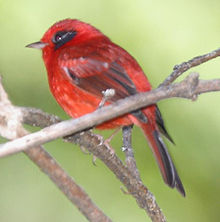
Back إرغاتيكوس Arabic ارغاتيكوس ARZ Ergaticus Breton Ergaticus Catalan Ergaticus CEB Ergaticus Esperanto Ergaticus French Ergaticus Dutch Ergaticus Polish Ergaticus WAR
| Ergaticus | |
|---|---|

| |
| Red warbler | |
| Scientific classification | |
| Kingdom: | |
| Phylum: | |
| Class: | |
| Order: | |
| Family: | |
| Genus: | Ergaticus Baird, 1865
|
| Species | |
|
E. ruber | |
Ergaticus was a genus of New World warblers — small passerine birds found only in the Americas. It was subsumed into Cardellina in 2011. The name is the Latinized version of the Ancient Greek ergatikos, meaning "willing or able to work". The genus contains two sister species: the red warbler, which is endemic to the Mexican highlands north of the Isthmus of Tehuantepec, and the pink-headed warbler, which is found south of the Isthmus, from the highlands of Chiapas, Mexico down into Guatemala. Though they are separated by geography and differ considerably in plumage, the two have sometimes been considered to be conspecific.
Both are average-sized warblers. Adult plumage is largely red, while juvenile plumage is largely "pinkish cinnamon-brown". The bill is small and narrow at the base even for a New World warbler. The tail is rounded and relatively long (Ridgway 1902). The songs consist of high-pitched chips and short trills (Howell and Webb 1995).
They live in forests at altitudes of 1,800 to 3,500 m (5,900 to 11,500 ft). They occur singly or in pairs and may join mixed-species feeding flocks (Howell and Webb 1995).
The nest is shaped like an old-fashioned oven with an opening to the top or side, made of pine needles, grass, or similar materials. It is placed on the ground or on a bank. Both can lay 3 or 4 eggs; the pink-headed warbler sometimes lays only 2. The eggs are off-white with reddish-brown and gray speckles (Howell and Webb 1995).
© MMXXIII Rich X Search. We shall prevail. All rights reserved. Rich X Search